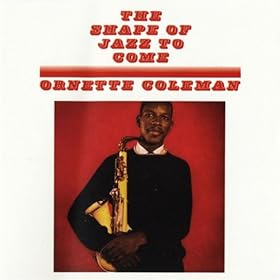
This "Record In Motion" segment is primarily for when I am listening to a record "in motion" (so basically for the first time) and will thus dish the dealio as it comes to me. So without further ado...this record, Ornette Coleman's The Shape of Jazz to Come.
I picked up this album today because it was 99cents at the Amazon music store and because they crowned it "the best jazz album" ever. Tall order, to say the least. I'm no jazz buff, though, but regardless it gives any album a lot of pressure on its first spin. I've heard some of the "more necessary" ones, like Miles Davis' Kind of Blue and Birth of the Cool, John Coltrane's A Love Supreme and Blue Train. I liked all those, though I would rank A Love Supreme and Kind of Blue as superior works to the other two. So being no real jazz cat, this album proves to be interesting.
From what I can understand, this record is the first avant-garde jazz record. No piano to ground it down in chordal structures, so basically Ornette Coleman and his cornet-toting partner get to roam free, often playing the same lines or settling in implied harmonies. There are slower moments on the record where the two saunter around in that strange, classy manner in which only a jazz cat can evoke, but there are those times when Ornette Coleman or his compatriot spew out fire at lightning speed. Technically, it's really grabbing, and Coleman's skill is simply undeniable on this record. Of course, being technically good at an instrument doesn't grant you "jazz cat" status immediately, in my opinion, so I must look towards more intangible aspects.
As this is free-form, avant-garde stuff, the (most) important aspect of it is to maintain flow. To continuously play at 100 miles a minute for the whole record is not tasteful, nor elegant nor praiseworthy. Neither is a record that simply sits on its harmonies without exploring melody, which is simply boring. A player in this setting, from what I can tell, has to be able to adapt to all circumstances, to know when to indulge in virtuosity or when to delve deeper into harmonies and melodic exploration. That seems to be key to me. From what I can tell, Ornette Coleman and company do a fine job with this. Coleman is obviously the leader, and he communicates his melodic ideas well, and to give major due props to the other members for being able to support and complement the guy's sax playing with deftness and grace, neither encroaching too much when Coleman takes center stage but more than capable to fill in those sonic holes when they need to be filled.
That's my general first hunch about this record. To me, jazz is more or less an acquired taste. It's not for everyone. There are the typical jazz records, then there are the weird jazz records, and then there are the even weirder "jazz records" (I'm looking at you, Interstellar Space Revisited). I know this method of classifying jazz records is in no way academic or near scientific, but to be honest jazz classification has almost gotten out of hand, so I'm simplifying it for my own use. To me, this particular record fits in between the "typical jazz" and "weird jazz" for me. But even at a first listen I do give this album its credit and my gratitude; perhaps this guy really knew what jazz was going to be "shaped" like and every other cat was just copying his groove. I'm not able to conclude that so quickly, though. So there comes with that a need for continued listening before I can place this in my favorite jazz albums list, however small that list may be...and so perhaps it's a list worth expanding.




No comments:
Post a Comment